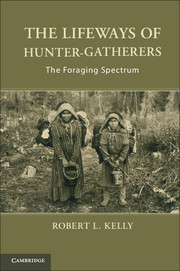Book contents
- Frontmatter
- Contents
- Tables
- Figures
- Preface
- Acknowledgments
- One Hunter-Gatherers and Anthropology
- Two Environment, Evolution, and Anthropological Theory
- Three Foraging and Subsistence
- Four Mobility
- Five Technology
- Six Sharing, Exchange, and Land Tenure
- Seven Group Size and Demography
- Eight Men, Women, and Foraging
- Nine Nonegalitarian Hunter-Gatherers
- Ten Hunter-Gatherers and Prehistory
- Notes
- References
- Index
Preface
Published online by Cambridge University Press: 05 April 2013
- Frontmatter
- Contents
- Tables
- Figures
- Preface
- Acknowledgments
- One Hunter-Gatherers and Anthropology
- Two Environment, Evolution, and Anthropological Theory
- Three Foraging and Subsistence
- Four Mobility
- Five Technology
- Six Sharing, Exchange, and Land Tenure
- Seven Group Size and Demography
- Eight Men, Women, and Foraging
- Nine Nonegalitarian Hunter-Gatherers
- Ten Hunter-Gatherers and Prehistory
- Notes
- References
- Index
Summary
I remember that I was amazed, amazed at the faces of Tasaday men and women looking back at me from the pages of National Geographic in 1972. To a young high school student who yearned to visit exotic places and to study prehistoric peoples, those photos of the Tasaday afforded the opportunity to do both vicariously. Here was the Stone Age! Hunters and gatherers, unsullied by civilization, who lived “much as our ancestors did thousands of years ago” (MacLeish and Launois 1972: 219).
Anthropology, the Tasaday, and, I like to think, I myself have come a long way since 1972. The Tasaday, of course, are not Pleistocene relics; frankly, I don't know what they were or are – perhaps they were only, as some say, pawns in a hoax perpetrated by the Philippine government for geopolitical reasons (see Headland 1992; Hemley 2003). But their legacy continues in the public and, sometimes, anthropology's perception of hunter-gatherers. The popular media likes to see hunter-gatherers as humanity stripped of its technological trappings, relics of the Paleolithic, people whom time forgot. Thus, they are often described by what they lack. The Tasaday, for example, apparently had “no agricultural implements…no woven cloth…no pipes…no pottery…no weapons…no word for war” (MacLeish and Launois 1972: 242). The Tasaday, and all hunter-gatherers, indeed seem to be “man in the raw state of nature” (Holmberg 1950: 261). And that is reason enough for us to know who foragers really are.
- Type
- Chapter
- Information
- The Lifeways of Hunter-GatherersThe Foraging Spectrum, pp. xv - xviiiPublisher: Cambridge University PressPrint publication year: 2013

